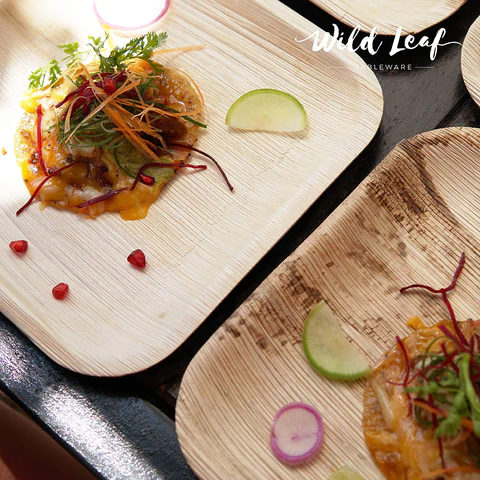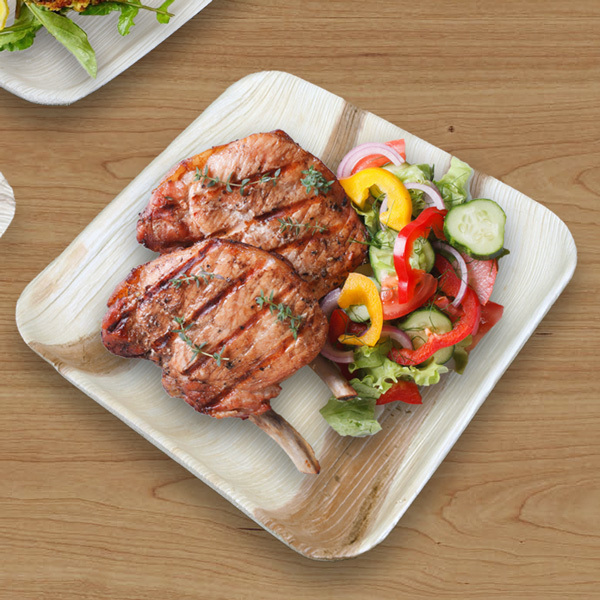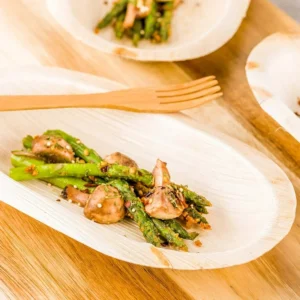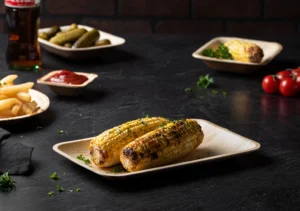
Palm Leaf Plates
In our current era, the call for sustainability grows increasingly urgent, compelling us to adopt eco-friendly practices in all facets of life, including dining. Palm leaf plates emerge as a prime example of how we can harmonize elegance with environmental stewardship. These naturally derived wonders provide a stylish, functional, and sustainable substitute for conventional tableware. Join us as we delve into the transformative potential of palm leaf plates, showcasing how they can revolutionize our tablescapes and, consequently, our commitment to preserving the environment.
Table of Contents
The Rise of Eco-Friendly Dining
As the tide of environmental awareness rises, so does the demand for sustainable dining solutions. The modern diner is not just a consumer but an eco-warrior, seeking ways to minimize their carbon footprint without compromising on style or functionality. This shift towards eco-friendly dining reflects a broader societal commitment to protect our planet for future generations.
Why Palm Leaf Plates?
- Environmentally Friendly: Palm leaf plates are made from the fallen leaves of the Areca palm tree, which means their production does not harm the tree or the environment. Unlike plastic plates, which can take hundreds of years to decompose, palm leaf plates are completely biodegradable and compostable, breaking down naturally within a few months.
- Sustainable Production: The use of fallen leaves in the production of these plates ensures a sustainable cycle that does not require cutting down trees or significant energy use. This process supports a sustainable model of consumption that contributes positively to the health of the planet.
- Chemical-Free: Palm leaf plates are produced without the use of chemicals, making them a safer option for both the environment and human health. In contrast, many disposable plates are manufactured using chemicals that can leach into food and pose health risks.
- Durability and Heat Resistance: Despite being completely natural, palm leaf plates are surprisingly sturdy and can handle hot, cold, wet, or oily foods without getting soggy or breaking. This makes them suitable for a wide range of dishes and serving requirements.
- Unique Aesthetic Appeal: Each palm leaf plate has a unique texture and pattern, adding a natural and elegant touch to any dining setting. This distinct look can enhance the presentation of meals and provide a talking point for guests about sustainability and eco-conscious dining choices.
- Versatility: Palm leaf plates are versatile enough for various occasions, from casual picnics and barbecues to formal dinners and weddings. Their natural elegance suits any décor theme, adding a rustic charm to events.
- No Water or Energy Wastage: The production of palm leaf plates does not require water or significant energy, unlike the manufacturing of paper or plastic plates. This further reduces their environmental impact and supports a low-carbon footprint.
- Compliance with Green Practices: For businesses and individuals aiming to comply with green practices, palm leaf plates offer an excellent way to align with eco-friendly standards and regulations. Using these plates can help reduce waste and promote sustainable practices in catering and event planning.

Crafting the Perfect Sustainable Table Setting
Choose Eco-Friendly Tableware
Start with the foundation of any table setting: the plates, bowls, and utensils. Opt for materials that are biodegradable, compostable, or recyclable. Palm leaf plates are an excellent choice for their unique texture, durability, and compostability. Pair these with utensils made from bamboo or wood, which are renewable resources and compostable. For drinks, glassware or recycled glass bottles add a touch of elegance and can be reused indefinitely.
Sustainable Linens
Instead of disposable paper napkins, choose cloth napkins made from natural fibers like cotton or linen. These materials are not only more sustainable but they also add a layer of sophistication to your table setting. For tablecloths or runners, look for organic or upcycled fabrics that minimize environmental impact.
Eco-Conscious Centerpieces
Create centerpieces that reflect the beauty of nature without harming it. Potted plants, succulents, or flowers in recycled glass vases make for stunning, eco-friendly decorations. You can also explore creative options like arranging seasonal fruits, vegetables, or even branches and stones for a more rustic look. These natural elements can be composted or repurposed after your event.
LED or Soy Candles
Illuminate your table setting with LED candles, which are reusable and safe, or choose candles made from soy or beeswax. Unlike traditional paraffin candles, soy and beeswax candles are biodegradable and burn cleaner, reducing indoor air pollution.
Reusable Drinkware
Encourage the use of reusable drinkware by providing guests with glass water bottles, mason jars, or recycled glass cups. Not only do these options reduce waste, but they also add a unique touch to your table setting.
Compost Bin
Set up a small, stylish compost bin near the dining area where guests can dispose of compostable waste. This encourages waste separation and highlights your commitment to sustainability.
Avoid Single-Use Plastics
Minimize the use of single-use plastics by avoiding plastic straws, stirrers, or plastic-wrapped items. Opt for alternatives like metal straws, wooden stirrers, and unwrapped condiments.
Personal Touches
Add personal touches that speak to your commitment to sustainability. This could be a small note explaining the eco-friendly choices you’ve made for your table setting or a seed paper menu that guests can plant after the event.
Educate and Inspire
Use your sustainable table setting as an opportunity to educate and inspire your guests about eco-friendly practices. Whether it’s through conversation or subtle hints within the setting itself, sharing knowledge about sustainability can have a ripple effect.
Choosing Your Palm Leaf Plates
Consider the Event Type
The nature of your event should influence the style and size of the palm leaf plates you select. For casual or outdoor events like picnics and barbecues, standard round plates might be the best fit. For more formal occasions, such as weddings or dinner parties, you might opt for plates with a more unique shape or design to add an elegant touch.
Size Matters
Palm leaf plates come in a variety of sizes, from small appetizer plates to large dinner plates. Think about the courses you plan to serve and choose sizes that will accommodate the food appropriately. Using smaller plates for starters or desserts and larger plates for main courses can also help in portion control and reduce food waste.
Shape and Style
Palm leaf plates are available in several shapes, including round, square, rectangular, and even heart-shaped. The shape can significantly affect the presentation of your dishes, so consider what will best complement your menu. Additionally, the natural pattern and texture of the palm leaf can vary, so look for styles that align with your event’s aesthetic—whether you’re going for rustic charm or sleek sophistication.
Durability for Different Foods
While all palm leaf plates are designed to be sturdy and cut-resistant, some foods may require a more robust option. For example, if you’re serving dishes with sauce or gravy, ensure the plates you choose are deep enough or have a slight lip to prevent spills. For dry or solid foods, flatter plates might suffice.
Quantity and Packaging
Assess the number of guests and plan accordingly, considering some guests might go back for seconds. Additionally, check how the plates are packaged. Many suppliers offer bulk packaging, which can be more cost-effective and reduce packaging waste. However, ensure that the plates are packaged in a way that protects them from damage and maintains their quality.
Eco-Friendly Credentials
While palm leaf plates are inherently eco-friendly, it’s worth researching the supplier’s environmental practices. Look for plates that are ethically sourced and produced without harmful chemicals. Certifications or product information detailing the sustainable practices of the company can provide peace of mind that you’re making an environmentally responsible choice.
Compostability and Disposal
Confirm the compostability of the palm leaf plates you’re considering. Most palm leaf plates can be composted in a home composting system or a commercial facility. Knowing this can help you plan for the disposal of the plates after your event, ensuring they are returned to the earth without harming the environment.
Test Before You Commit
If possible, order a sample pack of palm leaf plates before buying in bulk. This allows you to personally test the plates for size, style, durability, and overall quality. It’s also an excellent opportunity to see how they fit with your event’s theme and table settings.
Complementing Your Plates with Eco-Friendly Accessories
Bamboo or Wooden Cutlery
Bamboo and wooden cutlery are excellent alternatives to plastic utensils. They are biodegradable, compostable, and sourced from renewable resources. Their natural look and feel complement the aesthetic of palm leaf plates perfectly, adding to the rustic or earthy vibe of your table setting.
Glass Drinkware
Opt for glass drinkware to accompany your palm leaf plates. Glass is recyclable and can be reused indefinitely without losing quality or purity. For a more unique and eco-friendly touch, consider using mason jars or repurposed glass bottles as drinking glasses or for serving beverages.
Cloth Napkins
Switch out paper napkins for cloth ones made from natural fibers like cotton or linen. Not only are cloth napkins reusable, but they also add a touch of elegance to your table. Choose colors and patterns that match your theme or opt for natural, undyed fabrics for a minimalist look.
Reusable Straws
If your event includes drinks that require straws, provide reusable ones made from stainless steel, bamboo, or glass. These materials are not only sustainable but also elevate the drinking experience compared to disposable plastic straws.
Soy or Beeswax Candles
For evening events, lighting is key to creating ambiance. Soy or beeswax candles are eco-friendly lighting options that burn cleaner than traditional paraffin candles, emitting fewer pollutants and toxins. They also provide a warm, natural light that can make your table setting feel more intimate and cozy.
Sustainable Table Decor
Decorate your table with items that have a low environmental impact. Use natural materials like stones, leaves, or branches as centerpieces. Potted plants or succulents can also serve as beautiful, living decorations that guests can take home as a reminder of the event.
Eco-Friendly Serving Platters and Bowls
For serving communal dishes, choose platters and bowls made from sustainable materials like bamboo, wood, or recycled glass. These materials not only complement the palm leaf plates in style but also reinforce the eco-friendly theme of your event.
Compost Bin for Waste
Encourage guests to dispose of their compostable tableware properly by setting up a clearly labeled compost bin. This helps ensure that the palm leaf plates and other compostable items are disposed of in an environmentally responsible manner.
Eco-Friendly Packaging for Leftovers
If you anticipate leftovers, provide guests with eco-friendly packaging options, such as compostable containers or beeswax wraps. This allows guests to take food home without generating plastic waste.

From Casual Picnics to Elegant Dinners
Casual Picnics
For a laid-back, outdoor gathering, palm leaf plates offer a practical and stylish solution. Their sturdy construction can handle a variety of picnic foods, from sandwiches and salads to fruits and desserts. The unique patterns and textures of palm leaf plates add a touch of rustic charm to your picnic setup, enhancing the natural outdoor setting. Complement these plates with bamboo cutlery and reusable cloth napkins to minimize waste, and use mason jars or recycled glass bottles for beverages to maintain the eco-friendly theme.
Barbecues
Palm leaf plates are ideal for barbecues, where the fare tends to be hearty and sometimes messy. Their durability makes them capable of holding up to grilled meats, vegetables, and saucy dishes without bending or soaking through. The natural, organic look of palm leaf plates fits perfectly with the informal, communal atmosphere of a barbecue. Pair them with wooden serving platters and bowls for sides and condiments, and use cloth napkins and compostable wooden cutlery for an entirely sustainable event.
Family Gatherings
Family gatherings, whether indoors or outdoors, are an opportunity to showcase eco-friendly living without sacrificing style. Palm leaf plates can be dressed up or down to match the occasion. For a more cohesive look, select plates of uniform shape and size. Accent the table with natural elements like flower centerpieces in recycled glass vases and use soy candles for gentle, eco-friendly lighting. This setting not only creates a warm and inviting atmosphere but also sparks conversation about sustainable practices among family members.
Elegant Dinners
Palm leaf plates can rise to the occasion for formal events, offering a sophisticated and eco-conscious alternative to traditional dinnerware. Choose high-quality, uniformly shaped palm leaf plates for a more elegant presentation. Pair them with fine glassware, linen napkins, and silver or bamboo cutlery to elevate the dining experience. For centerpieces, consider minimalist arrangements of organic flowers or succulents. Lighting can be enhanced with beeswax candles, adding a soft, natural glow to the table. This combination of eco-friendly elegance is sure to impress guests and make your dinner party memorable.
Weddings and Special Events
For weddings and special events where sustainability is a priority, palm leaf plates provide a beautiful and practical solution. They can be part of a stunning table setting that aligns with the event’s eco-friendly ethos. Complement the plates with table linens made from natural fibers, and choose sustainable decor options, like biodegradable confetti and potted plants or herbs as favors. Palm leaf plates can handle everything from appetizers to main courses, making them a versatile choice for catering to large groups. Their unique appearance adds to the aesthetic of the event, showcasing the couple’s or organizer’s dedication to green living.
Transitioning with Accessories
The key to transitioning palm leaf plates across different types of events lies in the accessories and presentation. By adjusting the accompanying tableware, linens, and decor, you can create the perfect ambiance for any occasion, from the most casual to the most refined. This versatility, combined with their environmental benefits, makes palm leaf plates an excellent choice for conscious consumers looking to blend sustainability with style in their dining experiences.
Caring for and Disposing of Palm Leaf Plates
Caring for Palm Leaf Plates
- Use for Dry and Semi-Dry Foods: To extend the usability of palm leaf plates, it’s best to use them for dry and semi-dry foods. While they are quite sturdy and can handle some moisture, excessive liquid can eventually seep into the plate, making it less stable.
- Wipe Clean, If Necessary: If you wish to reuse a palm leaf plate within the same event, simply wipe it clean with a damp cloth. Avoid using soap or submerging it in water, as this can affect the integrity of the plate.
- Do Not Microwave for Extended Periods: Palm leaf plates can handle being microwaved for short durations. However, prolonged exposure to high temperatures can cause the plates to warp or become overly dry and brittle.
- Store in a Dry Place: If you have leftover plates or wish to keep them for future use, store them in a cool, dry place. Humidity can affect the plates over time, so it’s important to keep them away from moisture to maintain their shape and durability.

Disposing of Palm Leaf Plates
- Composting: The most environmentally friendly way to dispose of palm leaf plates is by composting them. These plates are 100% biodegradable and will break down naturally in a compost pile, turning into nutrient-rich soil over time. Depending on the conditions of your compost, palm leaf plates typically decompose within 2 to 6 months.
- Municipal Biodegradable Waste Collection: If you have access to a municipal biodegradable waste collection service, you can dispose of your palm leaf plates through this system. Check with your local waste management services to see if they accept compostable tableware.
- Educate Guests About Disposal: If you’re using palm leaf plates at an event, make sure to inform your guests about the proper disposal methods. Setting up clearly labeled bins for compostable waste can help ensure that the plates end up in the right place.
- Avoid Landfills If Possible: While palm leaf plates are biodegradable, disposing of them in landfills should be a last resort. In landfill conditions, where there is little oxygen, even biodegradable items can take much longer to break down and can contribute to methane production, a potent greenhouse gas.
Resources and Where to Buy
Online Retailers
Online shopping platforms are a great place to start looking for palm leaf plates. Websites like Amazon, Etsy, and eBay offer a wide range of options from various sellers. You can find plates of different shapes, sizes, and quantities to match your specific needs. Shopping online also allows you to compare prices and read customer reviews to ensure you’re getting a good quality product.
Eco-Friendly Specialty Stores
There are many online stores that specialize in eco-friendly and sustainable products, including tableware. Shops like Eco-Products, Green Paper Products, and Biodegradable Tableware focus on providing environmentally responsible items, including a variety of palm leaf plate designs. These stores often provide detailed information about the sustainability and sourcing of their products.
Local Health Food and Eco Stores
Many local health food stores and eco-friendly shops carry sustainable tableware options, including palm leaf plates. Shopping locally not only supports small businesses but also reduces the carbon footprint associated with shipping. Call ahead to inquire about their selection and availability.
Restaurant Supply Stores
If you’re looking for palm leaf plates in bulk, restaurant supply stores can be a good resource. They often sell eco-friendly tableware options to cater to the needs of businesses looking to reduce their environmental impact. This is a great option if you’re planning a large event or need a steady supply of sustainable tableware.
Wholesale Clubs
Wholesale clubs and bulk stores sometimes carry palm leaf plates as part of their eco-friendly product lines. Buying in bulk can be cost-effective, especially for large events or if you plan to use them regularly at home or in a business setting.
Direct from Manufacturers
Some manufacturers of palm leaf plates sell directly to consumers through their websites. Purchasing directly can offer the advantage of learning more about the production process, the source of the materials, and the company’s sustainability practices. This option might also provide savings by cutting out the middleman.
Sustainable Marketplaces
Marketplaces that focus on sustainable and eco-friendly products often feature palm leaf plates among their offerings. These platforms curate items from various brands, making it easier to shop for all your eco-friendly needs in one place.
Tips for Buying
- Check Certifications: Look for products that have certifications or clearly state their compostability and sustainability practices.
- Read Reviews: Customer reviews can provide insight into the quality and durability of the plates.
- Consider the Source: Opt for plates that are ethically sourced and produced in a sustainable manner.
- Bulk Purchasing: For events, consider buying in bulk to reduce packaging and overall costs.

Conclusion
Embracing palm leaf plates is more than a dining decision—it’s a commitment to sustainability and environmental stewardship. By choosing these eco-friendly alternatives, we contribute to a greener, cleaner planet, one plate at a time. Let’s make sustainable dining not just a choice but a way of life.
FAQs
- Are palm leaf plates safe for hot foods? Yes, palm leaf plates can safely hold hot foods, making them versatile for various dishes.
- How long do palm leaf plates take to compost? Palm leaf plates typically decompose within 60 to 90 days in a proper composting environment.
- Can palm leaf plates be used in the microwave? Yes, palm leaf plates are microwave safe for short periods, making them convenient for reheating food.
- Are palm leaf plates sustainable? Absolutely. Palm leaf plates are made from fallen leaves, require no trees to be cut down, and are fully compostable, making them an excellent choice for sustainable dining.
- Where can I buy palm leaf plates? Palm leaf plates are available at eco-friendly stores, certain supermarkets, and online platforms that specialize in sustainable goods.






